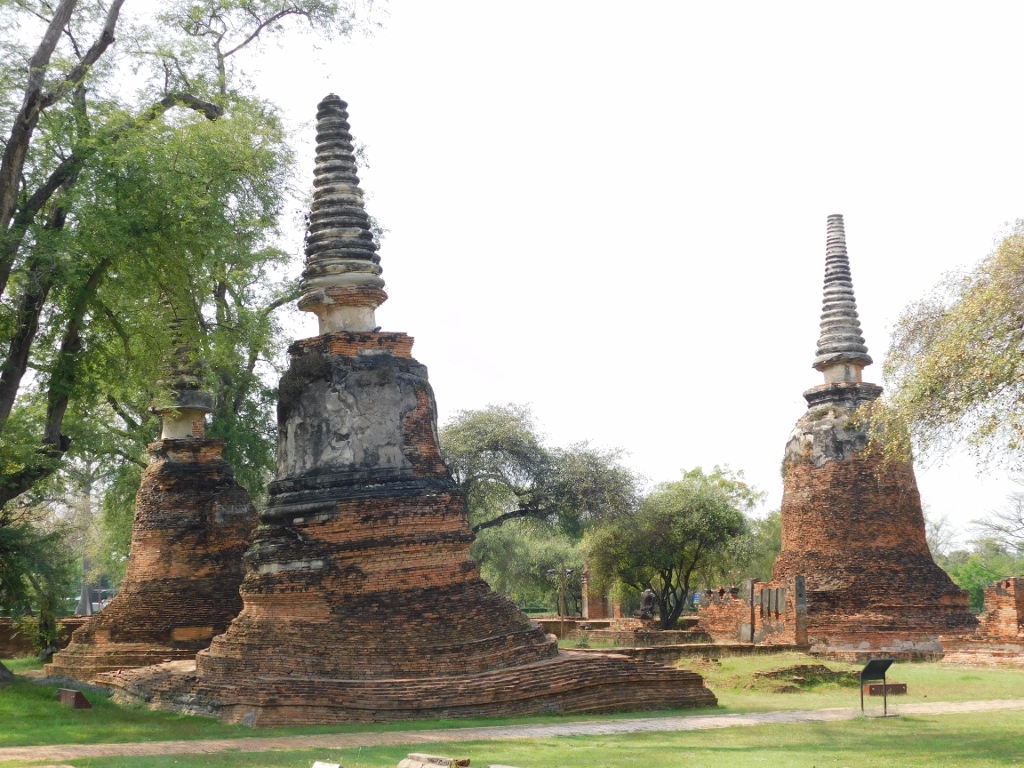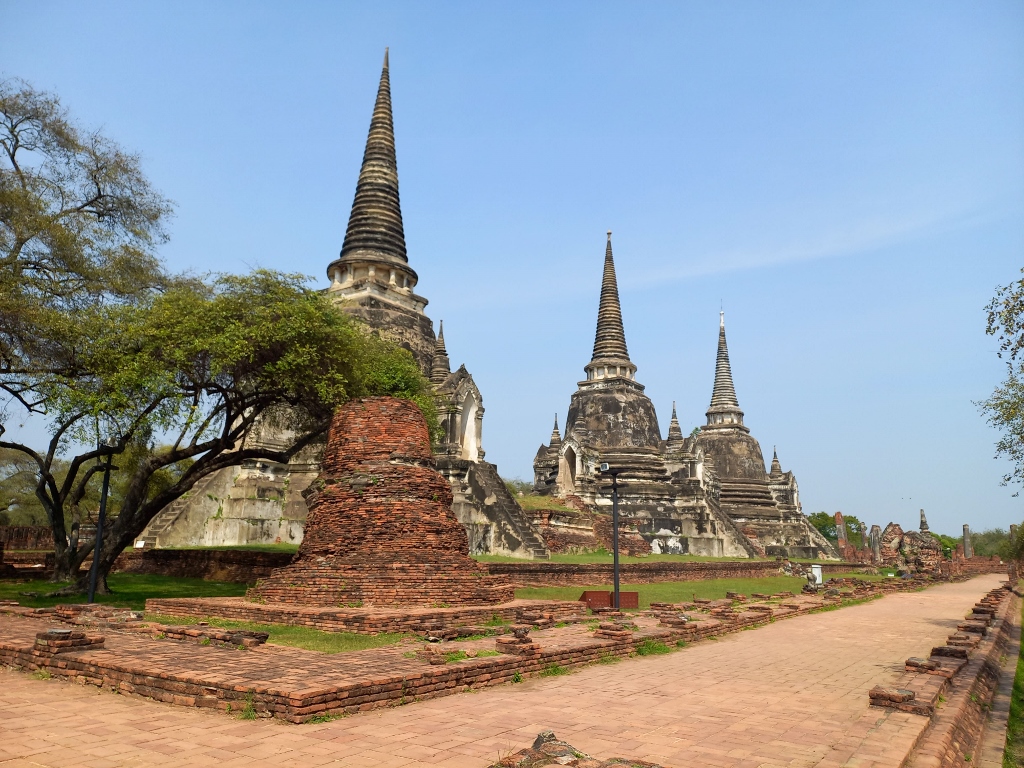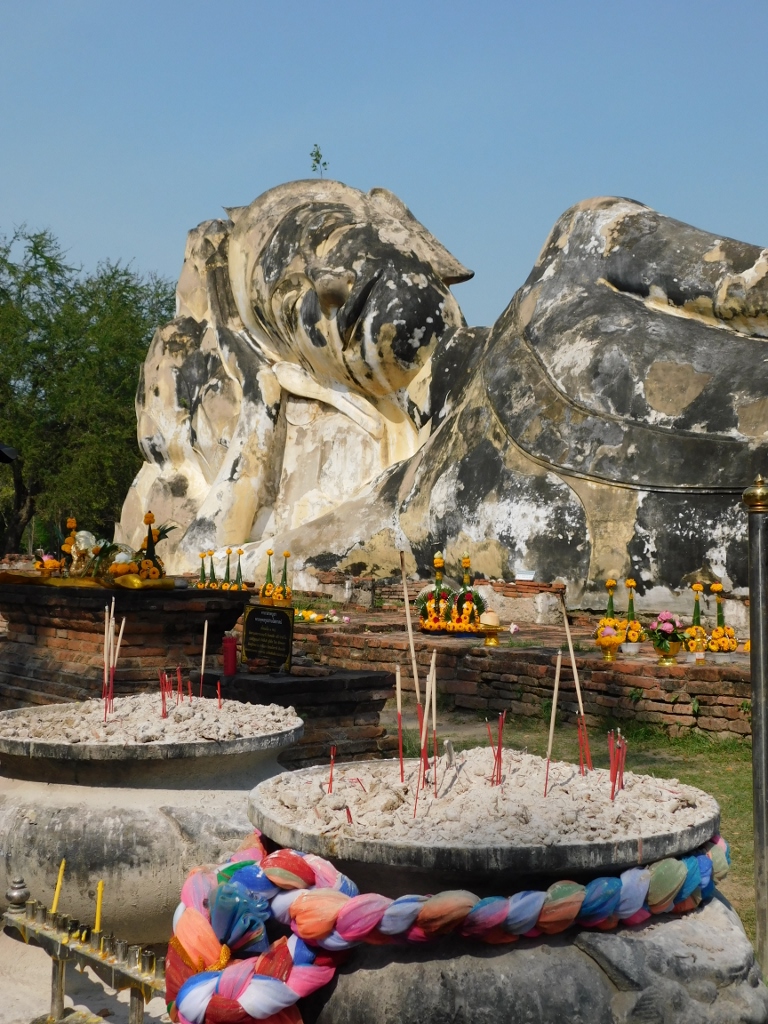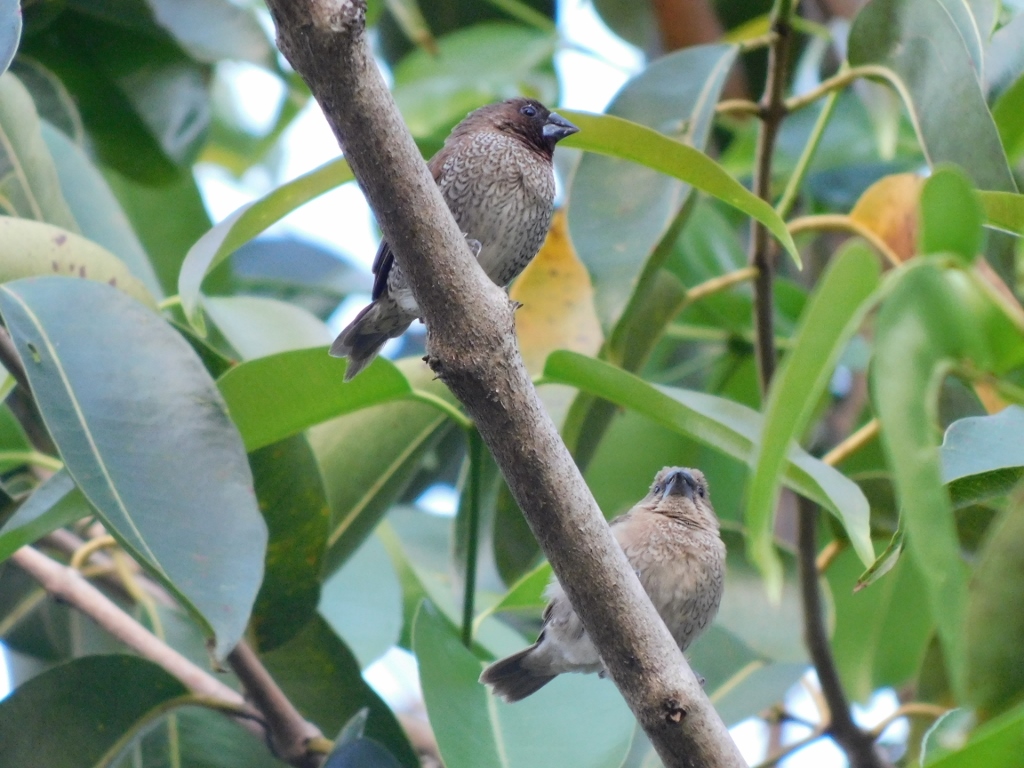While exploring the remains of the ancient capital of the Ayutthaya Kingdom (1351-1767), I also arrived at the temple of Wihan Phra Mongkhon Bophit, which is actually a completely modern temple, or more precisely a vihara, built in 1957.
 Wihan Phra Mongkhon Bophit
Wihan Phra Mongkhon Bophit
Still, the modern appearance should not be deceiving. This is indeed a more recent structure, but it was erected on the site of an earlier temple that was destroyed in the 18th century. During the Burmese invasion in 1767, the vihara was set on fire and damaged, and the roof was completely destroyed at that time. It remained in such a state until a new vihara was built in the 20th century.
What makes this temple very popular is the enormous and highly venerated Buddha statue from the 15th century (some sources mention the 16th century). The statue stands at a height of 12.5 m, with a width at the lap level of 9.5 m, making it one of the largest bronze Buddha statues in Thailand. To avoid any confusion, the statue is made of bronze, but in 1992, it was covered with gold leaf.
 Buddha statue in Wihan Phra Mongkhon Bophit
Buddha statue in Wihan Phra Mongkhon Bophit
This statue was also damaged during the Burmese invasion but has been gradually restored over time. By the way, the various poses in which the Buddha is depicted represent an exceptionally complex theme. Each posture carries its own symbolism and specific meaning, but, personally, I find it too complicated and beyond my basic interests, so I don’t go into too many details about it.
Right next to the temple of Wihan Phra Mongkhon Bophit, there are the remains of another famous historical temple, namely Wat Phra Si Sanphet.
 Wat Phra Si Sanphet
Wat Phra Si Sanphet
In the initial phase of the Ayutthaya Kingdom’s existence, the royal palace was located at this site. However, in the 15th century, it was relocated a few hundred metres further north and the reigning king at the time ordered the construction of a temple on this spot. As it was situated next to the palace, this became the royal temple used for the most important ceremonies and served as a private chapel for the royal family. Interestingly, unlike other temples in the capital of Ayutthaya, monks did not reside here; they only came when necessary.
The main feature of the temple is evident in the previous picture. Three impressive and well-preserved stupas contain the ashes of three kings who ruled from 1448 (when the construction of the temple was ordered) to 1529. The stupas are arranged on a partially elevated platform along the longitudinal axis of the temple complex that more or less runs in the east-west direction.
 Wat Phra Si Sanphet
Wat Phra Si Sanphet
 Wat Phra Si Sanphet, a detail
Wat Phra Si Sanphet, a detail
 Wat Phra Si Sanphet
Wat Phra Si Sanphet
The central part of the complex (with three chedis) was here also surrounded by a cloister, but today only its remains can be seen. There are also remnants of the main vihara that served as the royal chapel and, generally speaking, the entire area of the Wat Phra Si Sanphet temple complex was filled with chedis and smaller viharas.
 Wat Phra Si Sanphet
Wat Phra Si Sanphet
 Wat Phra Si Sanphet
Wat Phra Si Sanphet
Without delving too much into details, I simply started walking around the central part of the temple complex, following the visitor path and admiring what were once surely impressive structures.
 Wat Phra Si Sanphet
Wat Phra Si Sanphet
 Wat Phra Si Sanphet
Wat Phra Si Sanphet
Thus I came to the area located west of the platform with three large chedis. There, you can see the remains of old chedis, some of which are quite tilted today.
 Wat Phra Si Sanphet
Wat Phra Si Sanphet
There, I also came across the remains of a Buddha figure where it’s evident how large statues were made from bricks. Specifically, over the brick-formed basic shape, a special mortar was applied and then sculpted. This method gave the figures the appearance of being made of stone, while in fact, it was a more economical and simpler technique.
 Wat Phra Si Sanphet, a detail
Wat Phra Si Sanphet, a detail
By this time I almost completed a full circle around the central platform by walking around the site, so again I took some photos of the three chedis. They truly dominate the space.
 Wat Phra Si Sanphet
Wat Phra Si Sanphet
By the way, I should mention that the Wat Phra Si Sanphet temple was considered the most beautiful complex in the city and although the royal chapel did not survive (it was burned in 1767 during the war between Ayutthaya and Burma), it still served as inspiration for the ubosot of the Wat Phra Kaew temple in Bangkok (https://www.svudapodji.com/en/thailand-7/). Even the parts where only truncated remains are visible today clearly indicate how impressive the space must have been before the destruction by the Burmese.
As the ground plan of the temple complex takes the form of a long rectangle, along the longer sides, there are remains of alternately arranged smaller viharas and chedis – only the foundations of viharas are visible today, while the chedis are damaged to various degrees.
 Wat Phra Si Sanphet
Wat Phra Si Sanphet
Still, the strongest impression is made when the space and the various structures found there are considered as a whole.
 Wat Phra Si Sanphet
Wat Phra Si Sanphet
I found it interesting to read that there was once a standing Buddha statue in this temple, 16 metres tall and covered with 343 kg of gold. When the Burmese captured Ayutthaya, they melted down this statue. I have to say that I don’t really understand Buddhism, but it’s genuinely perplexing to me how some people who consider themselves Buddhists (like the Burmese) could destroy a Buddha statue. I can comprehend war (though I generally disagree), but melting down a Buddha – not so much. Granted, I fully understand that similar criticisms can arise in the context of religious wars between different branches of Christianity or Islam. However, as a translator and interpreter, I assert that it’s all a result of the corrupt nature of humanity and the “selling of stories” – neither the Buddha, nor Christ, nor Allah engage in war and destruction; it’s people who do and the excuses can always be found, claiming that it’s done “in the name of God.”
Now, I only lingered at a couple of places more in order to examine the details of the central chedis and then I could leave the site.
 Wat Phra Si Sanphet, a detail
Wat Phra Si Sanphet, a detail
 Wat Phra Si Sanphet, a detail
Wat Phra Si Sanphet, a detail
By the way, I should mention that to the north of the Wat Phra Si Sanphet temple, there are remains of the old royal palace, but today only the foundation remains and low walls are visible. I had to be mindful of the time, plus I was also tired, not to mention the heat.
Therefore, for a start, I sat in a “restaurant” area next to the Wihan Phra Mongkhon Bophit temple. On the one hand, I wanted to buy more water and, on the other, I wanted to sit in the shade, look at my guide and spare my brain from boiling in the heat.
I remembered reading that there was a large Reclining Buddha at one of the temples and I wanted to see that, too. Since I hadn’t planned to do a proper visit there, I managed to arrange with a motorcycle taxi driver to take me to that temple first, wait for me to take some photos and then bring me back to the “centre.” And that’s exactly what happened.
This concerns the remains of the Wat Lokkayasutha temple, near which there are two more smaller but interesting temples. If I were staying in Ayutthaya for a few days, I would certainly like to stroll around them, but this way I only made it to the Reclining Buddha. I didn’t even explore the temple’s remains. Admittedly, from what I saw, only the central prang and the low foundations of several smaller structures remain, so there’s no regret.
 Reclining Buddha at the Wat Lokkayasutha temple
Reclining Buddha at the Wat Lokkayasutha temple
The Reclining Buddha figure is 42 meters long and 8 meters tall, and it was restored in 1954. The statue was originally housed within a vihara and based on certain details it can be inferred that it was created after the 16th century. The figure is often wrapped in bright orange fabric, as it is now a significant site for Thai pilgrims.
 Offerings for the Reclining Buddha at the Wat Lokkayasutha temple
Offerings for the Reclining Buddha at the Wat Lokkayasutha temple
Now I finished my sightseeing tour of the historical park in Ayutthaya, so the motorcycle taxi driver took me back to the centre. I still had to take a photo of him when I got off the motorcycle and paid him, and that was it.
 Public transportation in Ayutthaya
Public transportation in Ayutthaya
And then I crossed the street and went to one of the numerous restaurants in the tourist area of Ayutthaya, where I refreshed myself with a nice soup. Soup is rarely a full meal for me, but this one was quite sufficient and there was also rice, so together it filled my stomach nicely. On the other hand, I wanted to take in a different type of liquid, not just plain water.
 Revitalising soup in Ayutthaya
Revitalising soup in Ayutthaya
Afterwards, I walked to the place where mini-buses for Bangkok stop and soon thereafter I set off.
 Return to Bangkok
Return to Bangkok
Along the way, there was occasionally an indescribable traffic jam. I realised how fortunate I was to live in a city the size of Belgrade (around 1.5 million inhabitants) and not spend hours and days of my life stuck in traffic.
Be as it may, when I got off the mini-bus in Bangkok, I faced a small problem. I wanted to go to the new large Bang Sue railway station to check exactly when I had the train the next day, but the railway station and the mini-bus station are at a very inconvenient distance. Too far to walk after a tiring day and too close for taxi drivers to be willing to take you. Well then. After a few unsuccessful attempts to get a taxi, I asked a motorcycle taxi driver who happened to be there and he kindly took me where I wanted to go.
When I got there, not only did I find out when I had the train the next day, but I also purchased a ticket and took a closer look at what the station looked like and exactly where I needed to go. I really enjoy these “dry runs.”
Now I could catch a taxi and it brought me nicely and relatively quickly near the hotel, where I first went for dinner. The restaurant seemed quite improvised and I didn’t see any menus.
 Restaurant in Bangkok
Restaurant in Bangkok
However, I realised I didn’t really need a menu, since I could have something simple – fried rice with chicken and along with it I could enjoy a beer. They didn’t have a small beer, while the dish was exceptionally tasty, which all made the dinner perfect.
 Dinner in Bangkok
Dinner in Bangkok
The restaurant had one significant advantage – it was very close to my hotel. I was very tired and exhausted, partly due to a lot of walking and partly due to the heat. However, when I arrived in my room, a lovely surprise awaited me, so I almost started jumping with joy. Just kidding. I was indeed happy, but I certainly didn’t jump around the room.
This was all about a lovely bouquet of flowers sent to me by Luke, the son of my friend Rajna. We weren’t able to meet as planned, so he came up with a thoughtful way to apologise. There was no need for an apology, but I was truly delighted by both the flowers and the surprise.
 Flower bouquet in Bangkok
Flower bouquet in Bangkok
Since I was departing from Bangkok by train the next day at 10:35, there was no need to rush in the morning. To start with I had a good night’s sleep and then even had time to go down to the hotel’s terrace by the canal, where I enjoyed a relaxed beginning of the day and a nice cup of coffee.
Then, I took a taxi to the Bang Sue railway station and settled into the train, which departed right on time.
But first, let me mention the impressive new Bang Sue station. Technically, this railway station is called Krung Thep Aphiwat Central Terminal, but everyone still refers to it as Bang Sue. It became Bangkok’s main railway station for intercity traffic just a month before my arrival and is connected to the city’s Blue Line underground. So, if someone is travelling around Thailand using the railway, it’s easy to get from the station to the city centre and vice versa, for instance.
 Bang Sue railway station
Bang Sue railway station
I continued my journey in the third class, but I found it quite charming, so I stuck with it for the remainder of my travels in Thailand. While better accommodations may be more comfortable, they are often less picturesque than those on the lower scale. On the other hand, all classes travel at the same speed and sitting in the third class didn’t mean I didn’t have a reservation or my own booked seat.
 Third class on a Thai train
Third class on a Thai train
For starters, it was interesting for me to see how “No Smoking” is written in Thai.
 A detail from the train
A detail from the train
But what I enjoyed the most was sitting by the window and observing the passing scenery. In the beginning, it was parts of Bangkok reflecting the rapid development of this multimillion city.
 Bangkok, a detail
Bangkok, a detail
I have already mentioned how impressed and surprised I was by the remarkable transportation infrastructure and now I could see it from the train as we slowly left Bangkok.
 Infrastructure for elevated highways or high-speed railway lines
Infrastructure for elevated highways or high-speed railway lines
This trip also made me realise that I could have taken a train to Ayutthaya since the railway line I was on that day goes directly there. However, my choice of a mini-bus wasn’t a bad one either. The main difference was in the surroundings. When I travelled by mini-bus the previous day, the road went through urbanised areas the entire time. On this occasion, I saw that you could also witness nature between Bangkok and Ayutthaya.
 View from the train on the way from Bangkok and Ayutthaya
View from the train on the way from Bangkok and Ayutthaya
However, I didn’t get off in Ayutthaya; instead, I continued on to the city of Pak Chong. When I arrived there and got off the train, I faced the fact that I had no idea where exactly I was and where I needed to catch transportation to the hotel, which was about 30 km away. I had some description in the guidebook, but it was poorly explained. So, I had to ask and people didn’t really speak English. Another significant problem was the heat, directly related to another issue – I was carrying a small backpack on my back and the larger one over my shoulder, thinking that I might immediately come across a taxi and it would be better for me to pay a little more but be at ease. Fate had a different plan – there were absolutely no taxis anywhere. Since I saw that my backpack carrying strategy wasn’t working at all, I put the larger backpack properly on my back and fastened it as it should be, placing the smaller one in front. What a difference that made! It was significantly easier for me to walk and the heat didn’t bother me as much.
But, there was still the issue of finding the place from where regular public transportation to the location of the reserved hotel started. However, with a few questions and following my instincts, I managed to arrive at this practically informal bus stop. The only indications that transportation started from there were two movable signs with the inscription Khao Yai and a fence preventing anyone else from parking there.
 Pak Chong, a detail
Pak Chong, a detail
While standing there, I idly browsed through the displays of nearby shops and in one I saw very charming sets that I presume are bought as gifts for, let’s say, newlyweds. Different sets include various items, but all come down to a combination of small things that might be needed when someone moves into a new home. For example: a pot, a blanket, a glass, a pen, a battery-powered lamp, soap, needles and thread, batteries, a spoon and fork, a lighter, a toothbrush...
 Pak Chong, a detail
Pak Chong, a detail
After about 20 minutes of waiting, a songthaew arrived. This is a type of public transport. It’s a truck adapted for passenger transport and you board it from the back.
 Songthaew in Pak Chong
Songthaew in Pak Chong
The name of this transport comes from two benches fixed along the sides of the truck. Once I settled inside with the other passengers, I simply had to take a selfie. It was my first ride in a songtaew, so it’s clear that I was positively excited.
 In the songthaew
In the songthaew
In such transport, there’s no need for any air conditioning since everything is open. However, passengers need to hold on well to avoid accidentally falling out.
 Songthaew on the move
Songthaew on the move
Exiting the vehicle is done by first pressing a pushbutton connected to a bell, and then the driver stops and leaves you right where you wanted to get off. Then, you approach the driver’s side and that’s when you actually pay for the ride. And that’s exactly what I did. I positioned my backpacks properly and then headed towards the hotel. There was a bit of wandering again because Google Maps are not always accurate (and until you try them, you don’t know when they are good or not). Anyway, I walked a bit more because of that, but eventually I reached the hotel.
On the way, I also saw and took photos of two cute little birds. They were scaly-breasted munias (Lonchura punctulata).
 Scaly-breasted munias
Scaly-breasted munias
Paying attention to nature made a lot of sense here because, although formally speaking I wasn’t in the Khao Yai National Park itself, I was only a few hundred metres away from the boundary of this significant park, which I planned to visit the next day.